HISTORY AND PRODUCTION
The products of EliPOT mainly comes from Europe and specifically from a country with a rich history, the country of Turkey. EliPOT delivers colorful and joyful hand-crafted arts directly from the hand of artists to the U.S market.
Elipot offers two main products:
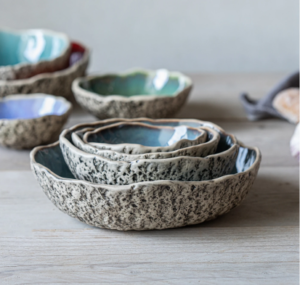
Handmade ceramic made out of clay, coming directly from Kütahya; center of world ceramic
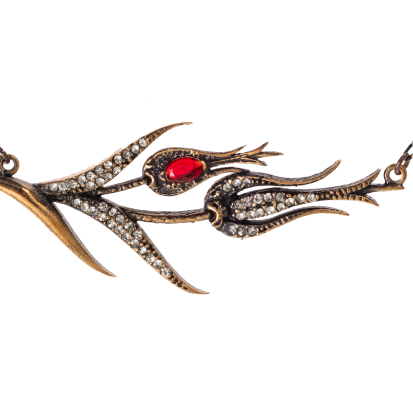
Handmade vintage jewelry, made of semi-precious metals and semi-precious stones
ROOTS IN HISTORY
The history of this magnificent art goes back thousands of years, the time human learned to keep precious things for later use or for the safe keeping. By the 8th century, the art of pottery entered into a new era of evolution, the Ceramic Making. Since then, ottomans have perfected the art of Ceramic Making to the new level of unparalleled beauty and magic. The history of ceramic goes back to Anatolia and has a big role in the culture and history of the people of Anatolia, the current country of Turkey.
Although, that type of ceramic still exists, by the 15th century with the changes in the culture of the Ottoman Empire, influenced by the 15th century Chinese Ming porcelains, early tile examples were very different from the style that later made İznik potters famous. It was not until the middle of the 16th century that the now iconic tulips, roses, pomegranates, and animals figures began to appear in the motifs, alongside the cobalt blue and turquoise patterns. the new designs and colors with wider varieties found their ways into the art of ceramic making. Before then the art of ceramic was solely being used in the Tile making and brick production.
In the middle of the 17th century, the Ottoman Empire’s economic distress and political upheavals inevitably affected the İznik potters as their products began to lose their vitality. By the 18th century the İznik ceramic industry almost died out completely with Kütahya replacing it as the leading center. However, the quality and vivacity of İznik tiles were never reached again. Today, Kütahya has enjoyed a revival as a center of tile and ceramic production.
The apparent beauty in the Süleymaniye Mosque (1557), the Tomb of Hürrem Sultan (1558), the Mosque of Rüştem Paşa (1561), the Tomb of Süleyman the I (1566), the Mosque of Sokullu Mehmed Paşa (1572), the Mosque of Piyale Paşa (1573), and the Valide Atik Mosque (1583), are few to name.
The Süleymaniye Mosque
(1557)
The Mosque of Rüştem Paşa
(1561)
The Tomb of Hürrem Sultan
(1558)
Throughout time artists brought this soul touching art into the daily life of the Anatolian people, as they hand crafted beautiful plates and bowls and other things with gorgeous shades and colors combinations. This evolution continued to the point that the new designs and color combinations use in each piece of ceramic, made ceramic art the most beautiful and sought after, souvenirs from Turkey, in the world.
The meaningful design which has a hidden secret and meaning behind each pattern and joyful colors has created such craft that has made it hard to take eyes off of them.
Turkish Ceramic Online USA
The soul-touching art, Turkish ceramic can be a perfect choice when you are looking for the most exquisite option for gifting purposes. Whether it is to gift someone or to enhance the appeal of your house, Turkish ceramic products can serve your purposes. Inspired by the latest designs, Turkish ceramics can add charm to any nook of your house. At EliPOT, we are providing an incredible range of Turkish ceramic online in the USA. The handmade items make space in anyone’s heart. Grab the attention of every individual; our hand-crafted Turkish ceramic items are renowned for their uniqueness and durability.
Shop handmade Turkish Ceramics
You can browse through our collection and place your order at a Turkish ceramics shop in the USA. Hurry, we have the best deals for you.
What types of Turkish ceramic products are available at EliPOT?
At EliPOT, you will get bowls, jars & pitchers, vases, animals, bottles, cups & mugs, decorative items, plates, and more inspired by Turkish design and patterns.
Are these Turkish ceramics handmade?
Yes, we have handmade Turkish ceramics that enhances the appeal of your house. So, browse through our collection of Turkish ceramics at EliPOT and place your order online at your leisure.
HISTORY AND PRODUCTION
The products of EliPOT mainly comes from Europe and specifically from a country with a rich history, the country of Turkey. EliPOT delivers colorful and joyful hand-crafted arts directly from the hand of artists to the U.S market.
Elipot has two major products:

Handmade ceramic made out of clay, coming directly from Kütahya; center of world ceramic

Handmade vintage jewelry, made of semi-precious metals and semi-precious stones
ROOTS IN HISTORY
The history of this magnificent art goes back thousands of years, the time human learned to keep precious things for later use or for the safe keeping. By the 8th century, the art of pottery entered into a new era of evolution, the Ceramic Making. Since then, ottomans have perfected the art of Ceramic Making to the new level of unparalleled beauty and magic. The history of ceramic goes back to Anatolia and has a big role in the culture and history of the people of Anatolia, the current country of Turkey.
Although, that type of ceramic still exists, by the 15th century with the changes in the culture of the Ottoman Empire, influenced by the 15th century Chinese Ming porcelains, early tile examples were very different from the style that later made İznik potters famous. It was not until the middle of the 16th century that the now iconic tulips, roses, pomegranates, and animals figures began to appear in the motifs, alongside the cobalt blue and turquoise patterns. the new designs and colors with wider varieties found their ways into the art of ceramic making. Before then the art of ceramic was solely being used in the Tile making and brick production.
In the middle of the 17th century, the Ottoman Empire’s economic distress and political upheavals inevitably affected the İznik potters as their products began to lose their vitality. By the 18th century the İznik ceramic industry almost died out completely with Kütahya replacing it as the leading center. However, the quality and vivacity of İznik tiles were never reached again. Today, Kütahya has enjoyed a revival as a center of tile and ceramic production.
The apparent beauty in the Süleymaniye Mosque (1557), the Tomb of Hürrem Sultan (1558), the Mosque of Rüştem Paşa (1561), the Tomb of Süleyman the I (1566), the Mosque of Sokullu Mehmed Paşa (1572), the Mosque of Piyale Paşa (1573), and the Valide Atik Mosque (1583), are few to name.
The Süleymaniye Mosque
(1557)
The Mosque of Rüştem Paşa
(1561)
The Tomb of Hürrem Sultan
(1558)
Throughout time artists brought this soul touching art into the daily life of the Anatolian people, as they hand crafted beautiful plates and bowls and other things with gorgeous shades and colors combinations. This evolution continued to the point that the new designs and color combinations use in each piece of ceramic, made ceramic art the most beautiful and sought after, souvenirs from Turkey, in the world.
The meaningful design which has a hidden secret and meaning behind each pattern and joyful colors has created such craft that has made it hard to take eyes off of them.
WHAT’S SPECIAL IN TURKISH CERAMICS
Due to its rich history of ceramic production, Turkey can be seen as the ‘land of ceramics’. These traditions have been colored
by the many different civilizations that have evolved in the Anatolian region. In addition to this cultural history, geography has
played an important role. The abundance of natural resources in Anatolia ensures high quality ceramic products and these raw
materials are also exported for ceramic production outside Turkey.
As well as being a world leader in ceramic production, Turkey has some of the most sophisticated technology and innovative
products on the market. Turkish ceramic producers work closely with some of the world’s most talented designers in order to
create exciting new products that are both beautiful and functional.
WHAT’S SPECIAL IN TURKISH CERAMICS
Due to its rich history of ceramic production, Turkey can be seen as the ‘land of ceramics’. These traditions have been colored by the many different civilizations that have evolved in the Anatolian region. In addition to this cultural history, geography has played an important role. The abundance of natural resources in Anatolia ensures high quality ceramic products and these raw materials are also exported for ceramic production outside Turkey.
As well as being a world leader in ceramic production, Turkey has some of the most sophisticated technology and innovative products on the market. Turkish ceramic producers work closely with some of the world’s most talented designers in order to create exciting new products that are both beautiful and functional.
WHAT ARE TILES MAIN
COLORS?
The innovative technique produced a bright white base that made the four traditional colors found in Iznik pieces–turquoise, cobalt, malachite, and coral–stand out under a thick transparent glaze*.
GLAZE
Glaze consist of silica, fluxes and aluminum oxide. Silica is the structural material for the glaze and if you heat it high enough it can turn to glass. Its melting temperature is too high for ceramic kilns, so silica is combined with fluxes, substances that prevent oxidation, to lower the melting point.
WHY IS
GLAZE USED ON
CERAMICS?
Ceramic glaze is an impervious layer or coating of a vitreous substance which has been fused to a ceramic body through firing. Glaze can serve to color, decorate or waterproof an item.
HOW IS CERAMIC
MATERIAL MADE?
Ceramics generally start with a clay-based material dug from the ground, then mixed with water (to make it soft and flexible) and other materials, squashed into shape, and finally fired at high-temperature in a large industrial oven called a kiln
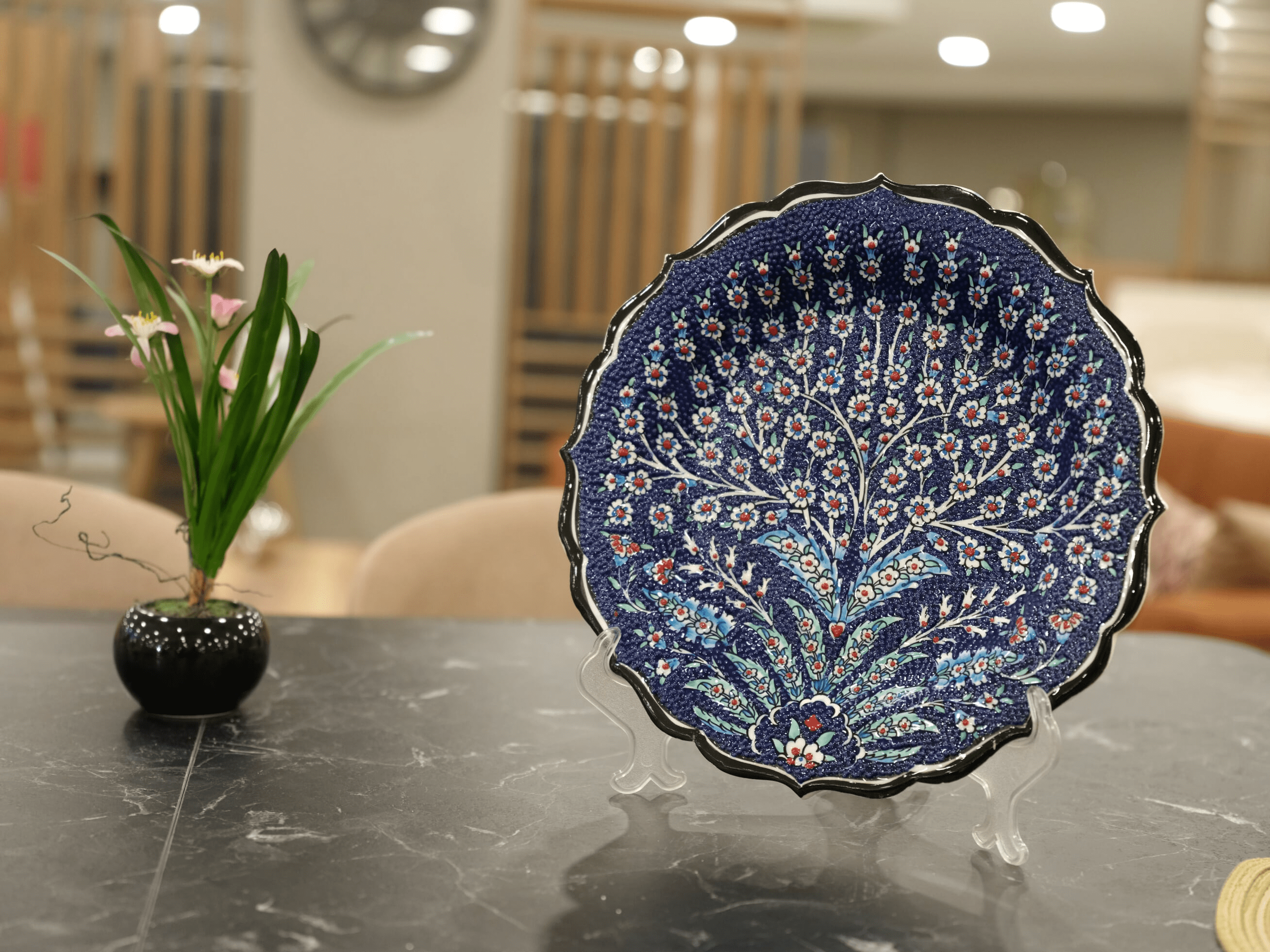
WHAT ARE TILES MAIN COLORS?
The innovative technique produced a bright white base that made the four traditional colors found in Iznik pieces–turquoise, cobalt, malachite, and coral–stand out under a thick transparent glaze*.
GLAZE
Glazes consist of silica, fluxes and aluminum oxide. Silica is the structural material for the glaze and if you heat it high enough it can turn to glass. Its melting temperature is too high for ceramic kilns, so silica is combined with fluxes, substances that prevent oxidation, to lower the melting point.
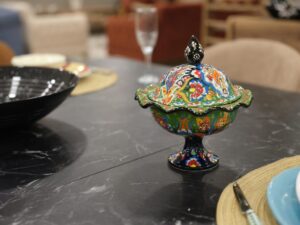
WHY DO WE USE GLAZE ON CERAMICS?
Ceramic glaze is an impervious layer or coating of a vitreous substance which has been fused to a ceramic body through firing. Glaze can serve to color, decorate or waterproof an item.
WHAT IS THE PROCESS
OF MAKING A CERAMIC
PIECE?
- The process starts by creating the base, whether tile or another piece; 85 percent of this base is made with locally sourced ground quartz (the rest is clay and silica). bases are dried for seven to 10 days and then covered with a thick underglaze made of quartz and clay. At this point, they are air dried for another 10 days, then baked at 930 degrees in giant kilns.
- The next step is the most intricate. The traditional geometric and floral motifs (the latter featuring tulips, roses, and carnations) are drawn on sketching paper, perforated with a needle, and transferred onto the base using charcoal dust. The tiny traces of charcoal are then carefully contoured with a black dye and the designs are painted with natural metal oxide colors. Copper oxide produces a rich cobalt blue, and iron oxide turns into the distinctive, deep Iznik red
- The last step, glazing, is where the magic happens. The painted base is glazed with a thick off-white mixture of quartz, metal oxides, and soda called sir, which translates to “secret” in Turkish: The original masters never wrote down the formula, but rather passed it down orally. This final coating adds a satin finish, draws out depth in the colors, and protects the piece from the elements. It also makes the ceramics virtually indestructible. Finally, the piece is air dried and kilned again for 12 continuous hours. Transformed by fire, the pale colors burst into intense, vivid hues, and the lustrous Iznik çini is born.

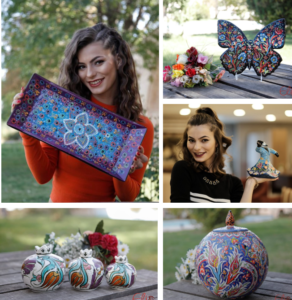
WHAT IS THE PROCESS OF MAKING A CERAMIC PIECE?
- The process starts by creating the base, whether tile or another piece; 85 percent of this base is made with locally sourced ground quartz (the rest is clay and silica). bases are dried for seven to 10 days and then covered with a thick underglaze made of quartz and clay. At this point, they are air dried for another 10 days, then baked at 930 degrees in giant kilns.
- The next step is the most intricate. The traditional geometric and floral motifs (the latter featuring tulips, roses, and carnations) are drawn on sketching paper, perforated with a needle, and transferred onto the base using charcoal dust. The tiny traces of charcoal are then carefully contoured with a black dye and the designs are painted with natural metal oxide colors. Copper oxide produces a rich cobalt blue, and iron oxide turns into the distinctive, deep Iznik red
- The last step, glazing, is where the magic happens. The painted base is glazed with a thick off-white mixture of quartz, metal oxides, and soda called sir, which translates to “secret” in Turkish: The original masters never wrote down the formula, but rather passed it down orally. This final coating adds a satin finish, draws out depth in the colors, and protects the piece from the elements. It also makes the ceramics virtually indestructible. Finally, the piece is air dried and kilned again for 12 continuous hours. Transformed by fire, the pale colors burst into intense, vivid hues, and the lustrous Iznik çini is born.
DIFFERENCE BETWEEN
POTTERY AND CERAMICS
Clay and ceramic are often used to describe different materials for making pottery. Clay is a type of ceramic, but not all ceramics
are made of clay. Clay is a natural material that comes from the ground, and ceramics are various materials that harden when heated,
including clay.
MATERIALS
Ceramics are made of materials that change molecular structure when they are heated. The process
of heating clay or ceramics is called firing. Ceramics contain a metal oxide, which is usually zirconium
oxide, silica oxide or silica carbide if it is made industrially.
TYPES OF CERAMICS
The term ceramic can encompass nearly any material that must be hardened using heat including bricks,
stoneware, china, porcelain and tile. Glaze that is put on the ceramic can also be considered a type of
ceramic itself as it hardens completely when it is fired.
MATERIALS
Clay is a group of moistened minerals that are naturally found in the soil, containing aluminum silicates and
crystalline silica. Clay can also contain different materials depending on where it is found,
including sand, barium carbonate or sulfur.
Industrial clay for use in pottery is often purchased as dry powder that is mixed with
water and then formed on a pottery wheel, but clay can also come in clumps of natural clay that is processed and cleaned.
Clay materials do not always have to be cured and will harden on their own but can still be susceptible to
disintegrating when they get wet.
METHODE
Both ceramics and clay are heated to form a hardened, finished product. All ceramics
and clay contain metal atoms and oxygen atoms, which form metal oxide crystals. The heating process bonds the metal
oxide crystals together as well as removes the water from the clay or ceramic. After heating, the ceramic or clay
item is a solid piece of pottery
DIFFERENCE BETWEEN
POTTERY AND CERAMICS
Clay and ceramic are often used to describe different materials for making pottery. Clay is a type of ceramic, but not all ceramics
are made of clay. Clay is a natural material that comes from the ground, and ceramics are various materials that harden when heated,
including clay.
MATERIALS
Ceramics are made of materials that change molecular structure when they are heated. The process of heating clay or ceramics is called firing. Ceramics contain a metal oxide, which is usually zirconium oxide, silica oxide or silica carbide if it is made industrially.
TYPES OF CERAMICS
Ceramics are made of materials that change molecular structure when they are heated. The process of heating clay or ceramics is called firing. Ceramics contain a metal oxide, which is usually zirconium oxide, silica oxide or silica carbide if it is made industrially.
MATERIALS
Clay is a group of moistened minerals that are naturally found in the soil, containing aluminum silicates and
crystalline silica. Clay can also contain different materials depending on where it is found,
including sand, barium carbonate or sulfur.
Industrial clay for use in pottery is often purchased as dry powder that is mixed with
water and then formed on a pottery wheel, but clay can also come in clumps of natural clay that is processed and cleaned.
Clay materials do not always have to be cured and will harden on their own but can still be susceptible to
disintegrating when they get wet.
METHODE
Both ceramics and clay are heated to form a hardened, finished product. All ceramics
and clay contain metal atoms and oxygen atoms, which form metal oxide crystals. The heating process bonds the metal
oxide crystals together as well as removes the water from the clay or ceramic. After heating, the ceramic or clay
item is a solid piece of pottery
IN SUMMERY
- Ceramics are not only made by clay but also other materials like glazes, while pottery is made up of only clay.
- Pottery is a form of ceramics. Ceramics is a broader aspect of molding certain materials into something artistic or something of use.
- Ceramics have a smoother surface with the new techniques of molding being used on it, pottery is still rough because of the old fashion ways it is created.
IN SUMMERY
- Ceramics are not only made by clay but also other materials like glazes, while pottery is made up of only clay.
- Pottery is a form of ceramics. Ceramics is a broader aspect of molding certain materials into something artistic or something of use.
- Ceramics have a smoother surface with the new techniques of molding being used on it, pottery is still rough because of the old fashion ways it is created.
HOW LONG DEOS IT TAKE TO
MAKE A SIMPLE PIECE?
The total time varies greatly with the complexity of the piece. Here is what it
takes to produce an “average” piece:
WEDGING
5 to 15 minutes
MAKING THE
BASE
varies based on complicity
THROWING
5 to 20 minutes
DRYING
24 to 48 hours
TIMMING
5 to 20 minutes
ATTACHING
OTHER PARTS
5 minutes to 5 hour
DRYING
2 days to 2 weeks or longer
LOADING KILN
20 to 30 minutes
BASE FIRING
18 to 20 hours
UNLOAD KILN
10 to 20 minutes
DRAWING AND
PAINTING
30 to 90 minutes
GLAZING
5 to 30 minutes
LOAD KILN
30 to 45 minutes
GLAZE FIRING
9 to 14 hours
UNLOAD KILN
10 to 20 minutes
INSPECT AND ADD
FINISHING TOUCHES
2 to 20 minutes
Preparation and clean up time are extra!
A simple piece can be completed in about 1 day to 30 days to make a base and hands-on/firing time; a
complicated piece may take 3 weeks or longer. This assumes that all goes according to schedule
and there are no accidents.
HOW LONG DEOS IT TAKE TO MAKE A SIMPLE PIECE?
The total time varies greatly with the complexity of the piece. Here is what it takes to produce an “average” piece:
WEDGING
5 to 15 minutes
MAKING THE
BASE
varies based on complicity
THROWING
5 to 20 minutes
DRYING
24 to 48 hours
TIMMING
5 to 20 minutes
ATTACHING
OTHER PARTS
5 minutes to 5 hour
DRYING
2 days to 2 weeks or longer
LOADING KILN
20 to 30 minutes
BASE FIRING
18 to 20 hours
UNLOAD KILN
10 to 20 minutes
DRAWING AND
PAINTING
30 to 90 minutes
GLAZING
5 to 30 minutes
LOAD KILN
30 to 45 minutes
GLAZE FIRING
9 to 14 hours
UNLOAD KILN
10 to 20 minutes
INSPECT AND ADD
FINISHING TOUCHES
2 to 20 minutes
Preparation and clean up time are extra!
A simple piece can be completed in about 1 day to 30 days to make a base and hands-on/firing time; a complicated piece may take 3 weeks or longer. This assumes that all goes according to schedule and there are no accidents.
SOURCING CLAY
Clays are used for making pottery, both utilitarian and decorative, and construction products, such as bricks, walls, and floor tiles. Different types of clay, when used with different minerals and firing conditions, are used to produce earthenware, stoneware, and porcelain.
PREPARING CLAY
Wedging is the technique of mixing and rolling clay to make it consistent and air bubble free. It’s a process of kneading the clay with a slight rotation that helps push out any air bubbles within the clay. Air bubbles will cause issues when throwing the clay on the wheel and if they remain in the clay during firing, they can cause the clay body to break or even explode.

Center clay on
wheel
Another technique that can cause new potters a lot of frustration. It will help you make well-formed pieces where the body wall has an even thickness.
CREATE FROM
(THROWING OFF THE
HUMP)
Throwing off the hump is a technique that many potters use to quickly make multiples of a form, typically a small form. In the technique, a large mound of clay is placed on the wheel and roughly centered. The potter can then center enough clay at the top for one form, throw the form, cut off, and repeat the process easily.

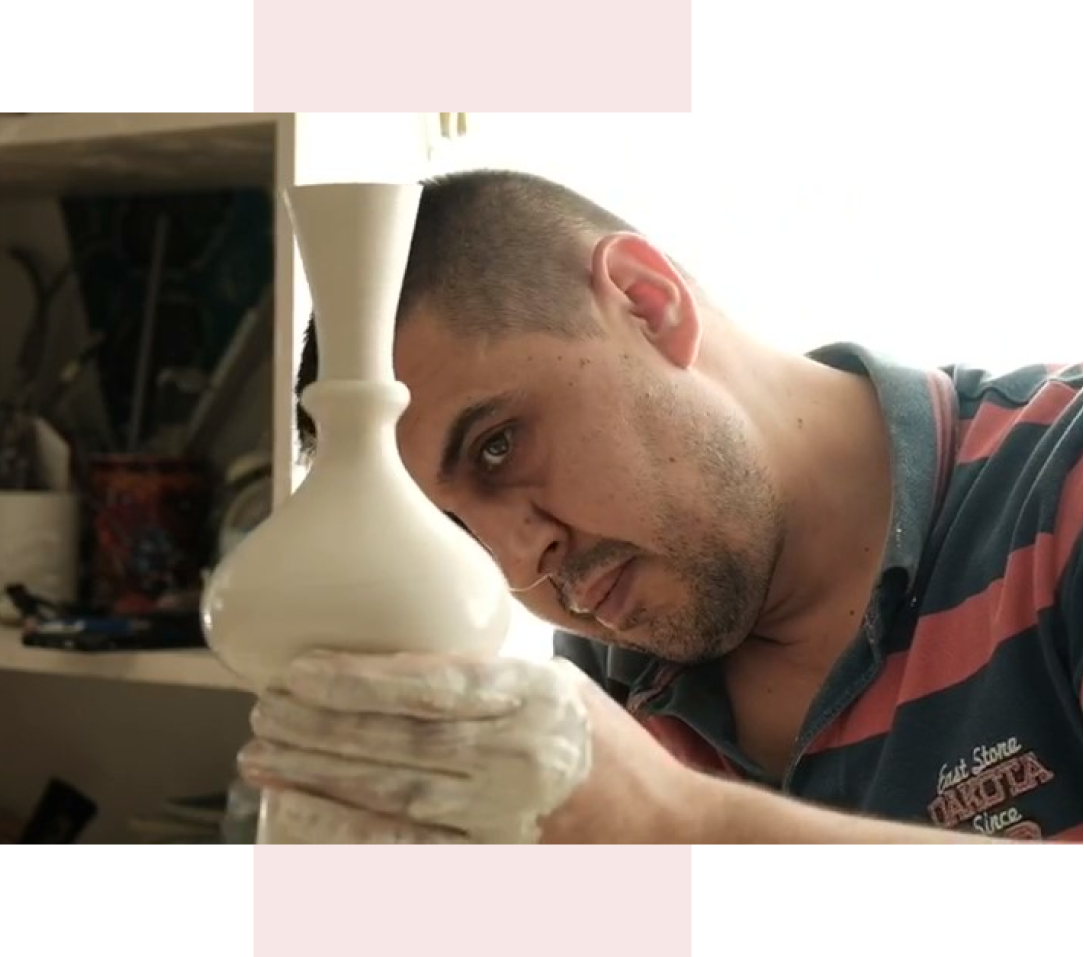
USE STRING TO
CUT A PIECE
OFF OF THE HUMP
Fishing line and uncoiled springs can be used as cut-off strings. They look a little like a wire cheese cutter. These tools are useful in cutting large lumps of clay as well as removing thrown ware from the potter’s wheel. When throwing off the mound, fishing line or other very flexible cut-off lines work best.
PLACE ON WARE
BOARD TO DRY
(LEATHER HARD)
For pieces to dry evenly and to a dryness that is perfect for trimming

STORE PIECES
COVERED FOR 1-2
DAYS
If clay isn’t completely dry quite yet, in addition to spritzing with a spray bottle, a wet towel or even paper towel is placed on the piece and seal it in your air-tight container. For1-2 days, your clay should have absorbed most of the moisture.
TRIM PIECES
Pieces can be trimmed on the wheel or by hand.
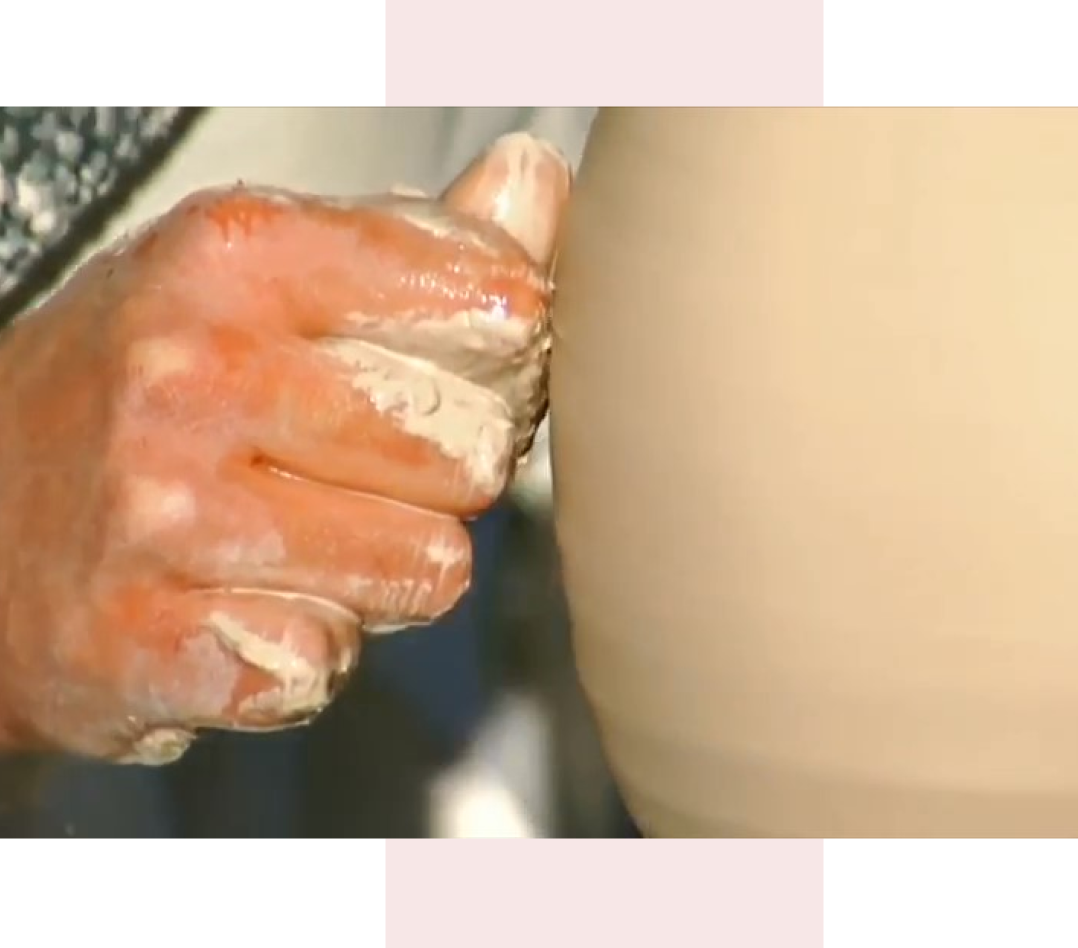
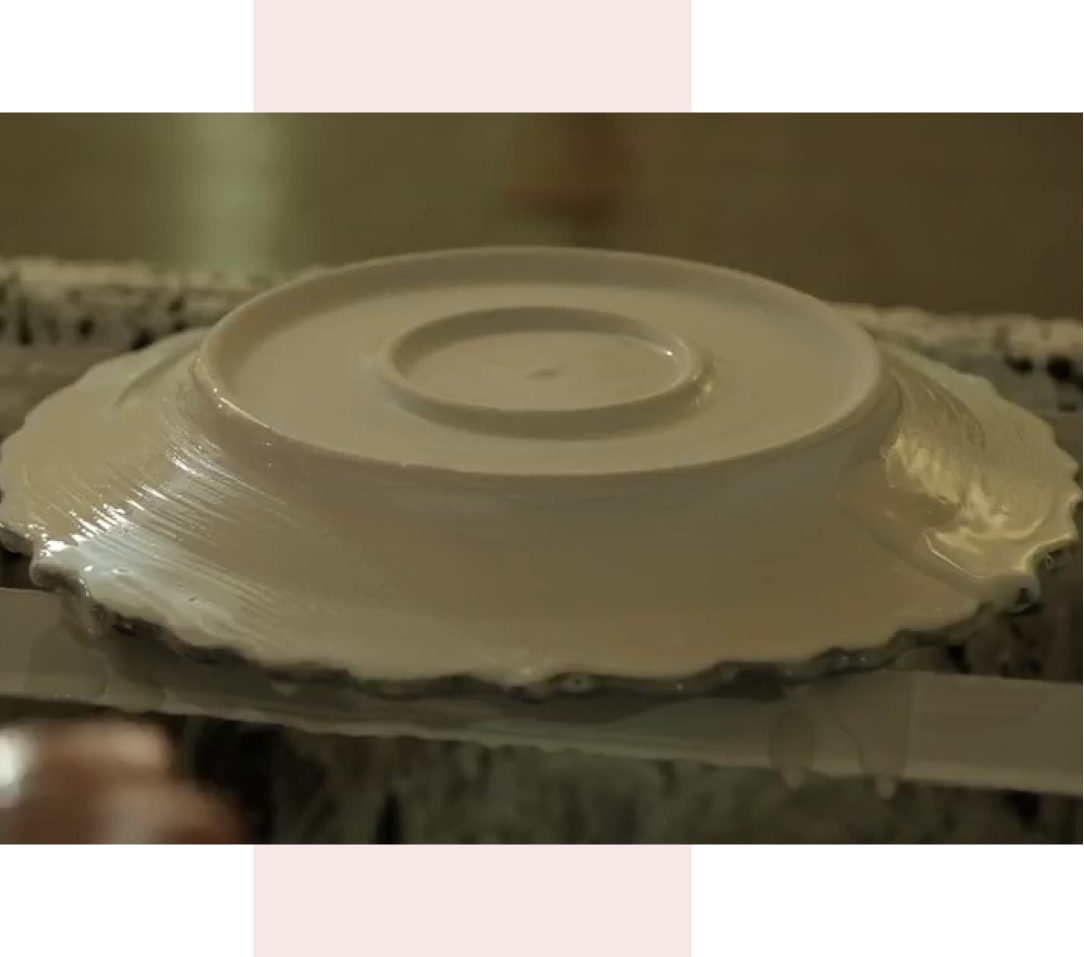
BASE FIRE
Bisque firing is the stage in which the pottery is turned from soft clay into hard ceramic.
GLAZE
There are many possibilities when glazing pottery and ceramics, from colorful patterns to mineral reactions. The general process of glazing ceramics is by mixing your glazes, applying the glaze to bisque-ware, letting it dry.
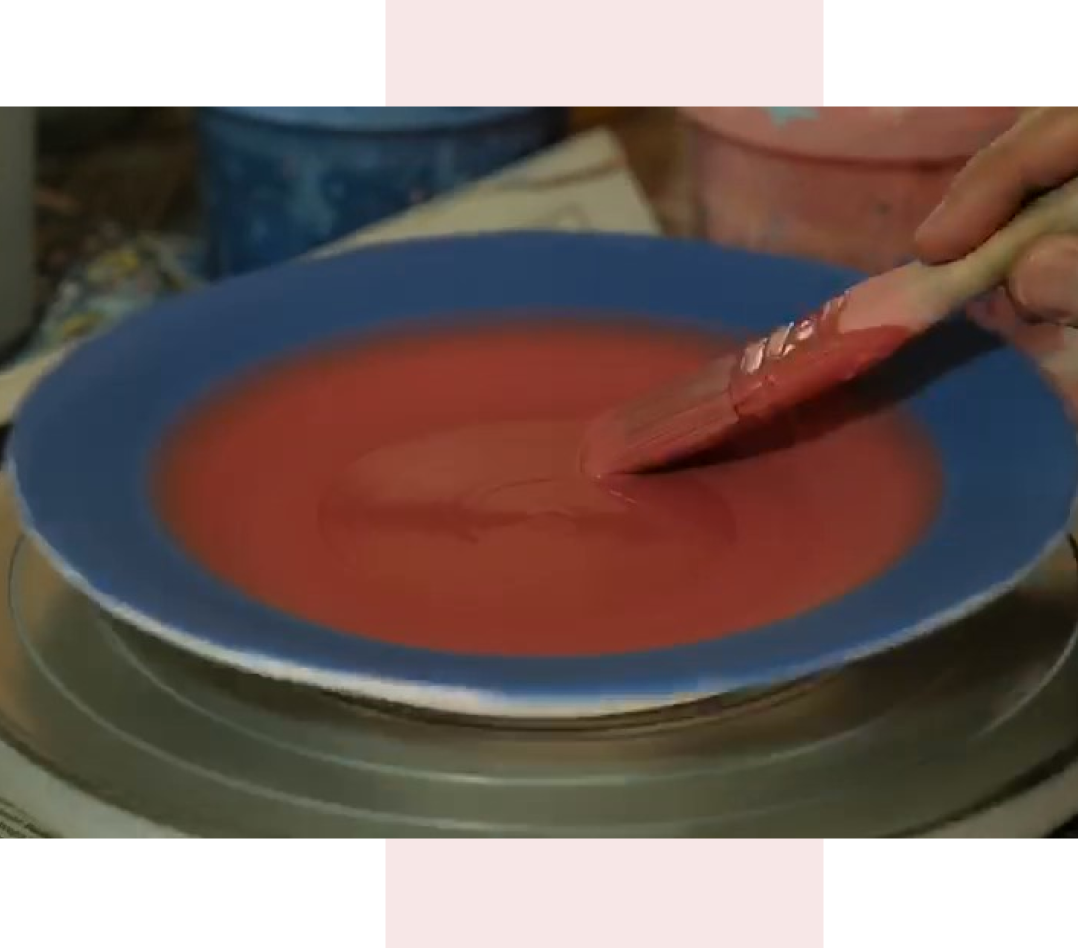
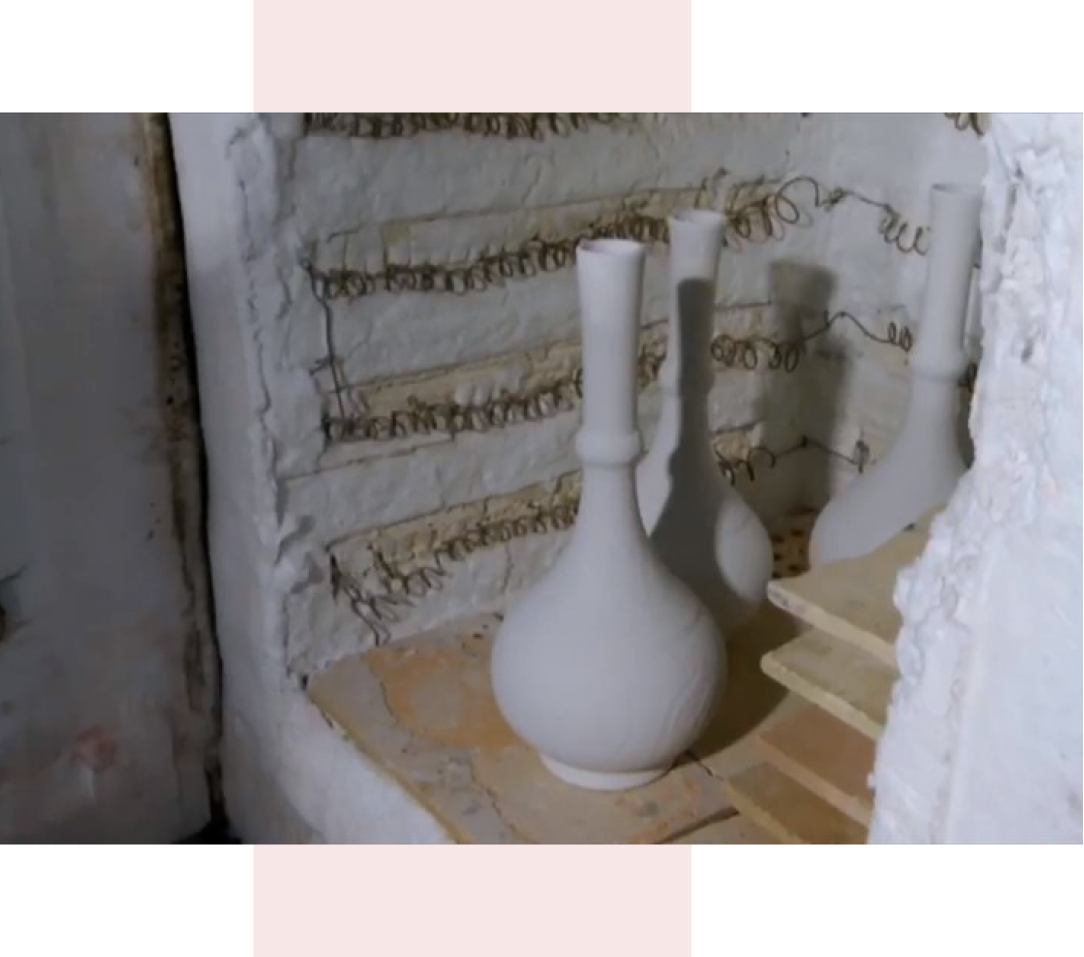
GLAZE FIRING
Finally, the made piece is placed in the kiln for the Glaze firing.
SAND/GRIND
After the glaze firing is complete, pieces usually need a quicksand or grind to ensure any sharp edges are removed.
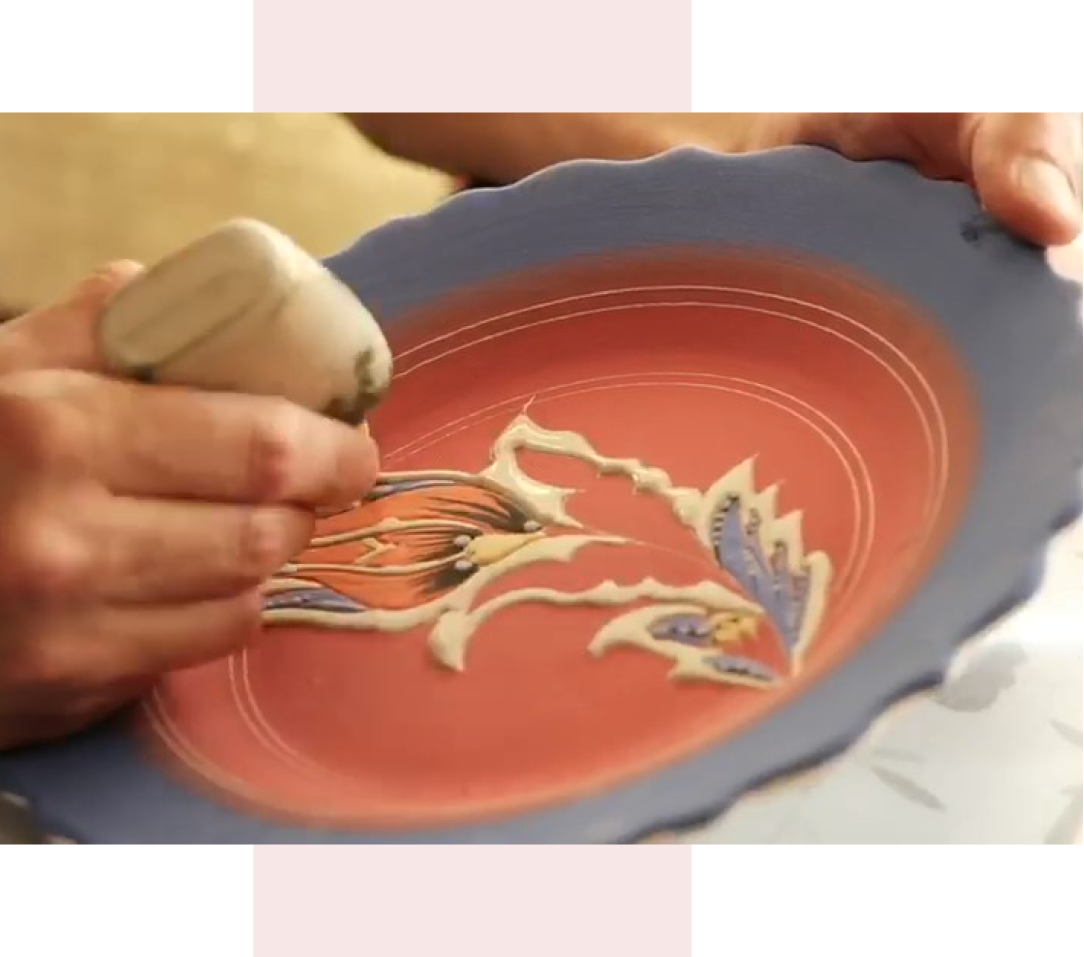
DRAW THE ART
In this stage, the artist either draw the art directly on the ceramic piece or first draw it on a special paper, which will be used later to trace on the ceramic piece. This stage is the most important stage and most delicate process. The beauty of the art and mixes of the colors are all dependent to the expertise of the artist who makes the ceramic piece.
COMPLETED AFTER
GOING TO FURNACE
Artist applies a layer of glaze to the bisqueware, leave it to dry, then load it in the kiln for its final step, glaze firing. The glazed item is carefully loaded into the kiln for the glaze firing. It must not touch anything. This step will be fusing the piece permanently.
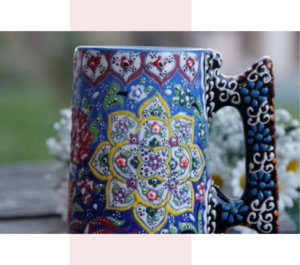
SOURCING CLAY
Clays are used for making pottery, both utilitarian and decorative, and construction products, such as bricks, walls, and floor tiles. Different types of clay, when used with different minerals and firing conditions, are used to produce earthenware, stoneware, and porcelain.
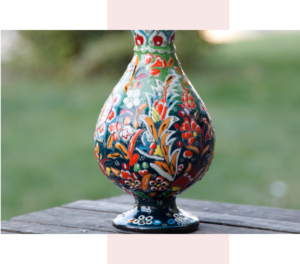
PREPARING CLAY
Wedging is the technique of mixing and rolling clay to make it consistent and air bubble free. It’s a process of kneading the clay with a slight rotation that helps push out any air bubbles within the clay. Air bubbles will cause issues when throwing the clay on the wheel and if they remain in the clay during firing, they can cause the clay body to break or even explode.

Center clay on
wheel
Another technique that can cause new potters a lot of frustration. It will help you make well-formed pieces where the body wall has an even thickness.

CREATE FROM (THROWING OFF THE HUMP)
Throwing off the hump is a technique that many potters use to quickly make multiples of a form, typically a small form. In the technique, a large mound of clay is placed on the wheel and roughly centered. The potter can then center enough clay at the top for one form, throw the form, cut off, and repeat the process easily.

USE STRING TO CUT A PIECE OFF OF THE HUMP
Fishing line and uncoiled springs can be used as cut-off strings. They look a little like a wire cheese cutter. These tools are useful in cutting large lumps of clay as well as removing thrown ware from the potter’s wheel. When throwing off the mound, fishing line or other very flexible cut-off lines work best.

PLACE ON WARE BOARD TO DRY (LEATHER HARD)
For pieces to dry evenly and to a dryness that is perfect for trimming
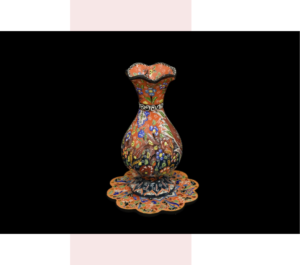
STORE PIECES COVERED FOR 1-2 DAYS
If clay isn’t completely dry quite yet, in addition to spritzing with a spray bottle, a wet towel or even paper towel is placed on the piece and seal it in your air-tight container. For1-2 days, your clay should have absorbed most of the moisture.

TRIM PIECES
Pieces can be trimmed on the wheel or by hand.

BASE FIRE
Bisque firing is the stage in which the pottery is turned from soft clay into hard ceramic.

GLAZE
There are many possibilities when glazing pottery and ceramics, from colorful patterns to mineral reactions. The general process of glazing ceramics is by mixing your glazes, applying the glaze to bisque-ware, letting it dry.

GLAZE FIRING
Finally, the made piece is placed in the kiln for the Glaze firing.
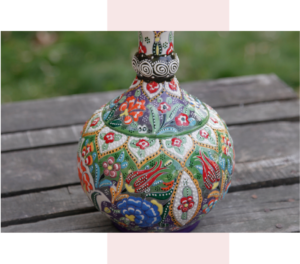
SAND/GRIND
After the glaze firing is complete, pieces usually need a quicksand or grind to ensure any sharp edges are removed.

DRAW THE ART
In this stage, the artist either draw the art directly on the ceramic piece or first draw it on a special paper, which will be used later to trace on the ceramic piece. This stage is the most important stage and most delicate process. The beauty of the art and mixes of the colors are all dependent to the expertise of the artist who makes the ceramic piece.
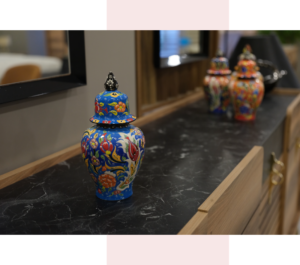
COMPLETED AFTER GOING TO FURNACE
Artist applies a layer of glaze to the bisqueware, leave it to dry, then load it in the kiln for its final step, glaze firing. The glazed item is carefully loaded into the kiln for the glaze firing. It must not touch anything. This step will be fusing the piece permanently.
This was all about making a simple piece of ceramics. Now you know how many hours should spend for making this beauty. Now imagine for making a colorful with detail motif how much a person should work hard and using his eyes and fingers
The money spent on buying a piece of ceramic, is not only for having a plate or vase, but it is for collect the result of hours spent on a master’s art.
It is our job to transmit the true concept of buying a piece of ceramic to customers; the true concept that he will be owning a piece of history made of the many generation’s knowledge, handed from father to son.


